List of military aircraft of the United States
| United States military aircraft |
|---|
|
This list of military aircraft of the United States includes prototype, pre-production, and operational types. For aircraft in service, see the List of active United States military aircraft. Prototypes are normally prefixed with "X" and are often unnamed (note that these are not the same as the experimental X-planes, which are not generally expected to go into production), while pre-production models are usually prefixed with "Y".
The United States military employs a designation and naming system to provide identifications to all aircraft types. Until 1962, the United States Army, United States Air Force (formerly Army Air Force), and United States Navy all maintained separate systems. In September 1962,[1] these were unified into a single system heavily reflecting the Air Force method. For more complete information on the workings of this system, refer to United States Department of Defense Aerospace Vehicle Designations.
This list does not include aircraft used by the U.S. military services prior to the establishment of a numerical designation system. For these aircraft, see List of military aircraft of the United States (1909–1919). It also does not include aircraft designated under the pre-1962 United States Navy designation system. For these aircraft, see List of military aircraft of the United States (naval).
Prior to 1919
Prior to 1919, all planes flown by the Army Air Service and the Navy were referred to by the designation given to them by their manufacturer. A variety of both domestic and foreign types were operated, with the latter being the primary front-line types during the First World War.
Army Air Service, 1919–1924

In September 1919, the Army Air Service decided that it needed an organized designation sequence, and adopted fifteen classifications, designated by Roman numerals. Several other unnumbered designations were added later. Each designation was assigned an abbreviation, and each design a number within that abbreviation. Variants were designated by alphabetically appending letters to the design number.
Type O: Foreign-Built Pursuit Aircraft
- Fokker D.VII – Fokker
- Fokker D.VIII – Fokker
Type I: Pursuit, water-cooled
- PW-1 – Engineering Division
- PW-2 – Loening
- PW-3 – Orenco
- PW-4 – Gallaudet
- PW-5 – Fokker
- PW-6 – Fokker
- PW-7 – Fokker
- PW-8 – Curtiss
- PW-9 – Boeing
Type II: Pursuit, night
- PN-1 – Curtiss
Type III: Pursuit, air-cooled
- PA-1 – Loening
Type IV: Pursuit, ground attack, 1922
Type V: Two-seat pursuit
- TP-1 – Engineering Division
Type VI: Ground attack, 1920–1922
Type VII: Infantry liaison
- IL-1 – Orenco
Type VIII: Night observation
- NO-1 – Douglas
- NO-2 – Douglas
Type IX: Artillery observation
Type X: Corps observation
- CO-1 – Engineering Division
- CO-2 – Engineering Division
- CO-3 – Engineering Division
- CO-4 – Atlantic
- CO-5 – Engineering Division
- CO-6 – Engineering Division
- CO-7 – Boeing
- CO-8 – Atlantic
Type XI: Day bombardment
- DB-1 – Gallaudet
Type XII: Night bombardment, short range
- NBS-1 – Martin (originally designated MB-2)
- NBS-2 – Lowe-Willard-Fowler
- NBS-3 – Elias
- NBS-4 – Curtiss
Type XIII: Night bombardment, long range
- NBL-1 – Witteman-Lewis
- NBL-2 – Martin
Type XIV: Trainer, air-cooled
- TA-1 – Elias
- TA-2 – Huff-Daland
- TA-3 – Dayton-Wright Aircraft
- TA-4 – Engineering Division
- TA-5 – Dayton-Wright Aircraft
- TA-6 – Huff-Daland
Type XV: Trainer, water-cooled
- TW-1 – Engineering Division
- TW-2 – Cox-Klemin
- TW-3 – Dayton-Wright Aircraft
- TW-4 – Fokker
- TW-5 – Huff-Daland
Ambulance, 1919–1924
Messenger
Pursuit, special
- PS-1 – Dayton-Wright
Racer
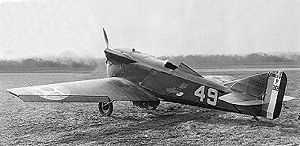
- R-1 – Alfred V. Verville
- R-2 – Thomas-Morse
- R-3 – Verville-Sperry
- R-4 – Loening
- R-5 – Thomas-Morse
- R-6 – Curtiss
- R-7 – Engineering Division
- R-8 – Curtisss
Seaplane
- S-1 – Loening
Transport
Army Air Corps/Army Air Forces/Air Force 1924–1962

Attack, 1924–1948
- A-1 – skipped to prevent confusion with Cox-Klemin XA-1
- A-2 – Douglas
- A-3 Falcon – Curtiss
- A-4 Falcon – Curtiss
- A-5 Falcon – Curtiss
- A-6 Falcon – Curtiss
- A-7 – Fokker
- A-8 – Curtiss
- A-9 – Lockheed
- A-10 Shrike – Curtiss
- A-11 – Consolidated
- A-12 Shrike – Curtiss
- A-13 – Northrop
- A-14 – Curtiss
- A-15 – Martin
- A-16 – Northrop
- A-17 Nomad – Northrop
- A-18 Shrike – Curtiss
- A-19 – Vultee
- A-20 Havoc – Douglas (redesignated as B-20 in 1948)
 A-20 Havoc
A-20 Havoc - A-21 – Stearman
- A-22 – Martin (assigned but none served with AAF)
- A-23 Baltimore – Martin
- A-24 Banshee – Douglas (redesignated as F-24 in 1948)
- A-25 Shrike – Curtiss
- A-26 Invader – Douglas (redesignated as B-26 in 1948, then as A-26 in 1966)
- A-27 – North American
- A-28 Hudson – Lockheed
- A-29 Hudson – Lockheed
- A-30 – Martin (assigned to allow supply to the UK under Lend-lease)
- A-31 Vengeance – Vultee
- A-32 – Brewster
- A-33 – Douglas
- A-34 – Brewster
- A-35 Vengeance – Vultee
- A-36 Apache/Invader – North American
- A-37 – Hughes
- A-38 Grizzly – Beechcraft
- A-39 – Kaiser-Fleetwings
- A-40 – Curtiss
- A-41 – Vultee
- A-42 Mixmaster – Douglas
- A-43 Blackhawk – Curtiss-Wright
- A-44 – Convair
- A-45 – Martin
Bomber

Until 1926, the Army Air Service had three sequences for bombers. Light bombers were indicated by the LB- prefix, medium bombers by the B- prefix, and heavy bombers by the HB- prefix. In 1926, the three-category system was scrapped and all bombers subsequently built were placed in the B- sequence.
Light Bomber, 1924–1926
- LB-1 – Huff-Daland (later Keystone)
- LB-2 – Atlantic Aircraft Corporation (Fokker Aircraft Corp after 1925)
- LB-3 – Keystone
- Martin LB-4 – serial number assigned but prototype not built
- LB-5 – Keystone
- LB-6 – Keystone
- LB-7 – Keystone
- LB-8 – Keystone
- LB-9 – Keystone
- LB-10 – Keystone
- LB-11 – Keystone
- LB-12 – Keystone
- LB-13 – Keystone
- LB-14 – Keystone
Medium Bomber, 1924–1926
- B-1 – Huff-Daland
- B-2 Condor – Curtiss
Heavy Bomber, 1924–1926
- HB-1 – Huff-Daland
- HB-2 – Atlantic/Fokker
- HB-3 – Huff-Daland
Unified bomber sequence, 1926–1962

- B-1 – Huff-Daland/Keystone
- B-2 Condor – Curtiss
- B-3 – Keystone
- B-4 – Keystone
- B-5 – Keystone
- B-6 – Keystone
- B-7 – Douglas
- B-8 – Fokker
- B-9 – Boeing
- B-10 – Martin
- B-11 – Douglas
- B-12 – Martin
- B-13 – Martin
- B-14 – Martin
- B-15 – Boeing
- B-16 – Martin
- B-17 Flying Fortress – Boeing
- B-18 Bolo – Douglas
- B-19 – Douglas
- B-20 – Boeing
- B-20 Havoc – Douglas (designation of A-20 Havoc from 1948 to 1949)
- B-21 – North American
- B-22 – Douglas
- B-23 Dragon – Douglas
- B-24 Liberator – Consolidated
 B-24 Liberator
B-24 Liberator - B-25 Mitchell – North American
- B-26 Marauder – Martin
- B-26 Invader – Douglas – designation of A-26 Invader from 1948 to 1966
- B-27 – Martin
- B-28 Dragon – North American
- B-29 Superfortress – Boeing
- B-30 – Lockheed
- B-31 – Douglas
- B-32 Dominator – Consolidated
- B-33 Super Marauder – Martin
- B-34 Lexington – Lockheed
- B-35 – Northrop
- B-36 Peacemaker – Convair
- B-37 – Lockheed
- B-38 Flying Fortress – Boeing
- B-39 Superfortress – Boeing
- B-40 Flying Fortress – Boeing
- B-41 Liberator – Consolidated
- B-42 Mixmaster – Douglas
- B-43 Jetmaster – Douglas
- B-44 Superfortress – Boeing
- B-45 Tornado – North American
- B-46 – Convair
- B-47 Stratojet – Boeing
- B-48 – Martin
- B-49 – Northrop
- B-50 Superfortress – Boeing
- B-51 – Martin
- B-52 Stratofortress – Boeing
_in_flight_061127-F-1234S-026.jpg) JB-52E Stratofortress
JB-52E Stratofortress - B-53 – Convair
- B-54 – Boeing
- B-55 – Boeing
- B-56 – Boeing
- B-57 Canberra – Martin
- B-58 Hustler – Convair
- B-59 – Boeing
- B-60 – Convair
- B-61 Matador – Martin (redesignated as TM-61, then MGM-1)
- B-62 Snark – Northrop (redesignated as SM-62)
- B-63 RASCAL – Bell (redesignated as GAM-63)
- B-64 Navaho – North American (redesignated as SM-64)
- B-65 Atlas – Convair (redesignated as SM-65)
- B-66 Destroyer – Douglas
- B-67 Crossbow – Radioplane (redesignated as GAM-67)
- B-68 – Martin
- B-68 Titan – Martin (redesignated as SM-68)
- B-69 Neptune – Lockheed
- B-70 Valkyrie – North American
- B-71 Blackbird – Lockheed[2]
- Beginning with #69, the "M-" (missile) and "B-" (bomber) series diverged. The missiles designated M-69 to M-92, some of which are incorrectly labeled as "formerly designated B-xx" in some sources, never used a "B-" series designation.
Bomber, long range, 1935–1936
A short-lived designation used from 1935–1936 to refer to three long-range bomber projects commissioned by the Army Air Corps. Most of the bombers were night bombers.
Cargo, 1924–1962
- C-1 – Douglas
- C-2 – Fokker
- C-3 – Ford
- C-4 – Ford
- C-5 – Fokker
- C-6 – Sikorsky
- C-7 – Fokker
- C-8 – Fairchild
- C-9 – Ford
- C-10 Robin – Curtiss-Wright
- C-11 Fleetster – Consolidated
- C-12 Vega – Lockheed
- C-13 – not used
- C-14 – Fokker
- C-15 – Fokker
- C-16 – Fokker
- C-17 Super Vega – Lockheed
- C-18 Monomail – Boeing
- C-19 Alpha – Northrop
- C-20 – Fokker
- C-21 Dolphin – Douglas
- C-22 Fleetster – Consolidated
- C-23 Altair – Lockheed
- C-24 – American/Fairchild
- C-25 Altair – Lockheed
- C-26 Dolphin – Douglas
- C-27 Airbus – Bellanca
- C-28 – Sikorsky
 Sikorsky C-28
Sikorsky C-28 - C-29 Dolphin – Douglas
- C-30 Condor – Curtiss-Wright
- C-31 – Kreider-Reisner
- C-32 – Douglas
- C-33 – Douglas
- C-34 – Douglas
- C-35 Electra – Lockheed
- C-36 Electra – Lockheed
- C-37 Electra – Lockheed
- C-38 – Douglas
- C-39 – Douglas
- C-40 Electra – Lockheed
- C-41 – Douglas
- C-42 – Douglas
- C-43 Traveller – Beechcraft
- C-44 – Messerschmitt
- C-45 Expeditor – Beechcraft
- C-46 Commando – Curtiss-Wright
- C-47 Skytrain – Douglas
 C-47 Skytrain
C-47 Skytrain - C-48 Skytrain – Douglas
- C-49 Skytrain – Douglas
- C-50 Skytrain – Douglas
- C-51 Skytrain – Douglas
- C-52 Skytrain – Douglas
- C-53 Skytrooper – Douglas
- C-54 Skymaster – Douglas
- C-55 Commando – Curtiss-Wright
- C-56 Lodestar – Lockheed
- C-57 Lodestar – Lockheed
- C-58 Bolo – Douglas
- C-59 Lodestar – Lockheed
- C-60 Lodestar – Lockheed
- C-61 Forwarder – Fairchild
- C-62 – Waco
- C-63 Hudson – Lockheed
- C-64 Norseman – Noorduyn
- C-65 Skycar – Stout
- C-66 Lodestar – Lockheed
- C-67 Dragon – Douglas
- C-68 – Douglas
- C-69 Constellation – Lockheed
- C-70 Nightingale – Howard
- C-71 Executive – Spartan
- C-72 – Waco
- C-73 – Boeing
- C-74 Globemaster – Douglas
 C-74 Globemaster
C-74 Globemaster - C-75 – Boeing
- C-76 Caravan – Curtiss-Wright
- C-77 – Cessna
- C-78 Bobcat – Cessna
- C-79 – Junkers
- C-80 – Harlow
- C-81 Reliant – Stinson
- C-82 Packet – Fairchild
- C-83 Coupe – Piper
- C-84 – Douglas
- C-85 Orion – Lockheed
- C-86 Forwarder – Fairchild
- C-87 Liberator Express – Consolidated
- C-88 – Fairchild
- C-89 – Hamilton
- C-90 – Luscombe
- C-91 – Stinson
- C-92 – Akron-Funk
- C-93 Conestoga – Budd
- C-94 – Cessna
- C-95 Grasshopper – Taylorcraft
- C-96 – Fairchild
- C-97 Stratofreighter – Boeing
 C-97 Stratofreighter
C-97 Stratofreighter- KC-97 Stratofreighter – Boeing
- C-98 Clipper – Boeing
- C-99 – Convair
- C-100 Gamma – Northrop
- C-101 Vega – Lockheed
- C-102 Sportster – Rearwin
- C-103 – Grumman
- C-104 – Lockheed
- C-105 – Boeing
- C-106 – Cessna
- C-107 Skycar – Stout
- C-108 Flying Fortress – Boeing
- C-109 Liberator Express – Consolidated
- C-110 – Douglas
- C-111 Super Electra – Lockheed
- C-112 – Douglas
- C-113 Commando – Curtiss-Wright
- C-114 Skymaster – Douglas
- C-115 Skymaster – Douglas
- C-116 Skymaster – Douglas
- C-117 Super Skytrain – Douglas
- C-118 Liftmaster – Douglas
- C-119 Flying Boxcar – Fairchild
- C-120 Packplane – Fairchild
- C-121 Constellation – Lockheed
- YC-121F Constellation – Lockheed
- C-122 Avitruc – Chase
- C-123 Provider – Fairchild
- XC-123A – Chase
- C-124 Globemaster II – Douglas
 From left to right: C-141, C-130, and C-124 with Mt. St. Helens in the background
From left to right: C-141, C-130, and C-124 with Mt. St. Helens in the background - C-125 Raider – Northrop
- C-126 – Cessna
- C-127 – Boeing
- C-128 Flying Boxcar – Fairchild
- C-129 Super Skytrain – Douglas
- C-130 Hercules – Lockheed
- C-131 Samaritan – Convair
- C-132 – Douglas
- C-133 Cargomaster – Douglas
- C-134 – Stroukoff
- C-135 Stratolifter – Boeing
- KC-135 Stratotanker – Boeing
- C-136 – Fairchild
- C-137 Stratoliner – Boeing
- C-138 – reserved for Fokker F27, but never assigned
- C-139 – Lockheed
- C-140 Jetstar – Lockheed
- C-141 Starlifter – Lockheed
- C-142 – Vought
- C-143 – reserved for what would become the X-19, but never officially assigned
- C-143 MRC2A – Bombardier Challenger CL-604 for US Coast Guard Medium Range Command and Control Aircraft[3]
- C-144 Ocean Sentry – CASA CN-235 300CG for US Coast Guard Medium Range Surveillance Maritime Patrol Aircraft (MRS MPA)[3]
- C-145 Skytruck - PZL M28 for special operations.
- C-146 - Dornier 328 for special operations.
Drone
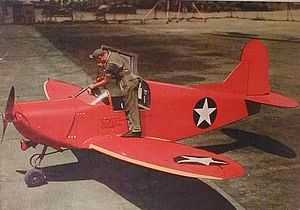
Aerial Target
1922–1935
- GL-1 Unmanned Coastal Artillery Target Glider - McCook Field Engineering Section
- GL-2 Manned Aerial Target Glider - McCook Field Engineering Section
- GL-3 Unmanned Aerial Target Glider (also known as "G-3") - McCook Field Engineering Section
1940–1941
- A-1 – Fleetwings
- A-2 – Radioplane
- A-3 – Curtiss
- A-4 – Douglas
- A-5 – Boeing
- A-6 – Douglas
- A-7 Airacobra – Bell
- A-8 Cadet – Culver
1942–1948
- PQ-8 Cadet – Culver
- PQ-9 – Culver
- PQ-10 – Culver
- PQ-11 – Fletcher
- PQ-12 – Fleetwings
- PQ-13 – ERCO
- PQ-14 Cadet – Culver
- PQ-15 – Culver
Aerial Target (Model Airplane), 1942–1948

- OQ-2 – Radioplane
- OQ-3 – Radioplane/Frankfort
- OQ-4 – Brunswick-Balke-Collender
- OQ-5 – contractor unknown
- OQ-6 – Radioplane
- OQ-7 – Radioplane
- OQ-11 – Simmonds Aerocessories
- OQ-12 – Radioplane
- OQ-13 – Radioplane
- OQ-14 – Radioplane/Frankfort
- OQ-16
- OQ-17 – Radioplane
- OQ-18
- OQ-19 Quail – Radioplane
Controllable bomb, 1942–1945
- BQ-1 – Fleetwings
- BQ-2 – Kaiser-Fleetwings
- BQ-3 – Fairchild
- BQ-3 – Fairchild
- BQ-4 – Interstate
- BQ-5 – Interstate
- BQ-6 – Interstate
- BQ-7 Aphrodite – Boeing
- BQ-8 Liberator – Consolidated[4]
Target Control, 1942–1948
- CQ-1 – Fletcher
- CQ-2 – Stinson
- CQ-3 Expeditor – Beechcraft
- CQ-4 Flying Fortress – Boeing
Unified sequence, 1948–1962
- Q-1 – Radioplane
- Q-2 Firebee – Ryan
- Q-3 – Radioplane
- Q-4 – Northrop
- Q-5 Kingfisher – Lockheed
- Q-6 – Wright Air Development Center
- Q-7 – skipped: request for redesignation of QB-17 not approved
- Q-8 Cadet Culver
- Q-8 – request for redesignation of QF-80 not approved
- Q-9 – WADC
- Q-10 – Radioplane
- Q-11 – WADC
- Q-12 – Beechcraft
- Q-14 Cadet – Culver
Glider
Assault Glider, 1942–1944
Bomb Glider, 1942–1944
Cargo Glider, 1941–1948
- CG-1 – Frankfort
- CG-2 – Frankfort
- CG-3 – Waco
- CG-4 Hadrian – Waco
- CG-5 – St. Louis
- CG-6 – St. Louis
- CG-7 – Bowlus-DuPont/Douglas
- CG-8 – Bowlus-DuPont/Douglas
- CG-9 – AGA Aviation
- CG-10 Trojan Horse – Laister-Kauffman
- CG-11 – Snead
- CG-12 – Read-York
- CG-13 – Waco
- CG-14 – Chase
- CG-15 Hadrian – Waco
- CG-16 – General Airborne Transport
- CG-17 – Douglas
- CG-18 – Chase
- CG-19 – Douglas
- CG-20 – Chase
Fuel Glider, 1930–1948
- FG-1 – Cornelius
Powered Glider, 1943–1948
Training Glider, 1941–1948
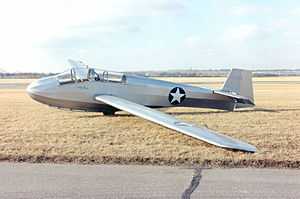
- TG-1 – Frankfort
- TG-2 – Schweizer
- TG-3 – Schweizer
- TG-4 – Laister-Kauffman
- TG-5 Grasshopper – Aeronca
- TG-6 Grasshopper – Taylorcraft
- TG-7 Orlik – Kocjan
- TG-8 Grasshopper – Piper
- TG-9 – Briegleb
- TG-10 – Wichita Engineering
- TG-11 – Schempp-Hirth
- TG-12 – Bowlus-DuPont
- TG-13 – Briegleb
- TG-14 – Stiglmeier
- TG-15 – Franklin-Stevens
- TG-16 – Schultz
- TG-17 – Franklin
- TG-18 – Midwest Sailplane
- TG-19 – Jacobs-Schweyer
- TG-20 – Laister-Kauffman
- TG-21 – Notre Dame
- TG-22 – Mehlhose
- TG-23 – Harper-Corcoran
- TG-24 – Bowlus-Dupont
- TG-25 Plover – Wolcott
- TG-26 – Universal
- TG-27 – Schneider
- TG-28 Hawk Junior – Haller
- TG-29 – Volmer Jensen
- TG-30 Bluebird – Smith
- TG-31 – Aero Industries
- TG-32 – Pratt-Read
- TG-33 – Aeronca
Unified sequence, 1948–1955
- G-2 – Ridgefield
- G-3 – Waco
- G-4 Hadrian – Waco
- G-10 Trojan Horse – Laister-Kauffman
- G-13 – Waco
- G-14 – Chase
- G-15 Hadrian – Waco
- G-18 – Chase
- G-20 – Chase
Sailplane, 1960–1962
- S-1 – Schweizer
- S-2 – Schweizer
Gyroplane, 1935–1939
- G-1 – Kellett
- G-2 – Pitcairn
Liaison, 1942–1962
- L-1 Vigilant – Stinson
- L-2 Grasshopper – Taylorcraft
- L-3 Grasshopper – Aeronca
- L-4 Grasshopper – Piper
- L-5 Sentinel – Stinson (redesignated as U-19 in 1962)
- L-6 Grasshopper – Interstate
- L-7 – Universal
- L-8 Cadet – Interstate
- L-9 – Stinson
- L-10 – Ryan
- L-11 – Bellanca
- L-12 Reliant – Stinson
- L-13 – Stinson/Convair
- L-14 Cub – Piper
- L-15 Scout – Boeing
- L-16 Champion – Aeronca
- L-17 Navion – North American/Ryan (redesignated as U-18 in 1962)
- L-18 Super Cub – Piper
- L-19 Bird Dog – Cessna (redesignated as O-1 in 1962)
- L-20 Beaver – de Havilland Canada (redesignated as U-6 in 1962)
- L-21 Super Cub – Piper (redesignated as U-7 in 1962)
- L-22 Navion – Ryan
- L-23 Seminole – Beechcraft (redesignated as U-8 in 1962)
- L-24 Courier – Helio (redesignated as U-24 in 1962)
- L-25 – McDonnell (redesignated as XH-35, then XV-1)
- L-26 Commander – Aero Design (redesignated as U-4 and U-9 in 1962)
- L-27 – Cessna (redesignated as U-3 in 1962)
- L-28 Super Courier – Helio (redesignated as U-10 in 1962)
Pursuit, 1924-1948/Fighter, 1948–1962

Designated P- for "pursuit" until 1948, when the United States Air Force was founded. After this, all P- designations were changed to F- ("fighter"), but the original numbers were retained.
- P-1 Hawk – Curtiss
- P-2 Hawk – Curtiss
- P-3 Hawk – Curtiss
- P-4 – Boeing
- P-5 Hawk – Curtiss
- P-6 Hawk – Curtiss
- P-7 – Boeing
- P-8 – Boeing
- P-9 – Boeing
- P-10 – Curtiss
- P-11 Hawk – Curtiss
- P-12 – Boeing
- P-13 Viper – Thomas-Morse
- P-14 – Curtiss
- P-15 – Boeing
- P-16 – Berliner-Joyce
- P-17 Hawk – Curtiss
- P-18 – Curtiss
- P-19 – Curtiss
- P-20 – Curtiss
- P-21 – Curtiss
- P-22 Hawk – Curtiss
- P-23 Hawk – Curtiss
- P-24 – Lockheed
- P-25 – Consolidated
- P-26 Peashooter – Boeing
 Boeing P-26
Boeing P-26 - P-27 – Consolidated
- P-28 – Consolidated
- P-29 – Boeing
- P-30 – Consolidated
- P-31 Swift – Curtiss
- P-32 – Boeing
- P-33 – Consolidated
- P-34 – Wedell-Williams
- P-35 – Seversky
- P-36 Hawk – Curtiss
- P-37 – Curtiss
- P-38 Lightning – Lockheed
- P-39 Airacobra – Bell
- P-400 - Royal Air Force Airacobra put into U.S. service before export
- P-40 Warhawk – Curtiss
- P-41 – Seversky
- P-42 – Curtiss
- P-43 Lancer – Republic
- P-44 Rocket – Republic
- P-45 – Bell
- P-46 – Curtiss
- P-47 Thunderbolt – Republic
- P-48 – Douglas
- P-49 – Lockheed
- P-50 – Grumman
- P-51 Mustang – North American
 P-51H Mustang
P-51H Mustang - P-52 – Bell
- P-53 – Curtiss
- P-54 Swoose Goose – Vultee
- P-55 Ascender – Curtiss
- P-56 Black Bullet – Northrop
- P-57 Peashooter – Tucker
- P-58 Chain Lightning – Lockheed
- P-59 Airacomet – Bell
- P-60 – Curtiss
- P-61 Black Widow – Northrop
- P-62 – Curtiss
- P-63 Kingcobra – Bell
- P-64 – North American
- P-65 – Grumman
- P-66 Vanguard – Vultee
- P-67 Bat – McDonnell
- P-68 Tornado – Vultee
- P-69 – Republic
- P-70 Nighthawk – Douglas
- P-71 – Curtiss
- P-72 – Republic
- P-73 – Hughes (officially never assigned)
- P-74 – skipped
- P-75 Eagle – Fisher
- P-76 – Bell
- P-77 – Bell
- P-78 – North American
- P-79 – Northrop
- F-80 Shooting Star – Lockheed
- P-81 – Convair
- F-82 Twin Mustang – North American
- P-83 – Bell
- F-84 Thunderjet – Republic
- F-85 Goblin – McDonnell
- F-86 Sabre – North American
 F-86F Sabre
F-86F Sabre - F-87 Blackhawk – Curtiss
- F-88 Voodoo – McDonnell
- F-89 Scorpion – Northrop
- F-90 – Lockheed
- F-91 Thunderceptor – Republic
- F-92 – Convair
- F-93 – North American
- F-94 Starfire – Lockheed
- F-95 – North American
- F-96 – Republic
- F-97 Starfire – Lockheed (redesignated as F-94C Starfire)
- F-98 Falcon – Hughes (redesignated as GAR-1, then AIM-4)
- F-99 BOMARC – Boeing (redesignated as IM-99, then CIM-10)
- F-100 Super Sabre – North American
- F-101 Voodoo – McDonnell
- F-102 Delta Dagger – Convair
- F-103 – Republic
- F-104 Starfighter – Lockheed
- F-105 Thunderchief – Republic
- F-106 Delta Dart – Convair
- F-107 – North American
- F-108 Rapier – North American
- F-109 – designation was reserved for the X-13 Vertijet, F-101B,[5] and Bell D-188A, but never officially assigned
- F-110 Spectre – McDonnell Douglas (redesignated as F-4 in 1962)
- F-111 Aardvark – General Dynamics
 General Dynamics F-111
General Dynamics F-111 - Unofficial designations YF-112 and up were later assigned to "black" projects – see Fighter series in Unified System.
Fighter, Multiplace
- FM-1 Airacuda – Bell
- FM-2 – Lockheed
Pursuit, Biplace
- PB-1 – Berliner-Joyce
- PB-2 – Consolidated
- PB-3 – Lockheed
Observation
Observation, 1924–1942
- O-1 Falcon – Curtiss
- O-2 – Douglas
- O-3 Mohawk – Dayton-Wright
- O-4 – Martin
- O-5 – Douglas
- O-6 – Thomas-Morse
- O-7 – Douglas
- O-8 – Douglas
- O-9 – Douglas
- O-10 – Loening
- O-11 Falcon – Curtiss
- O-12 Falcon – Curtiss
- O-13 Falcon – Curtiss
- O-14 – Douglas
- O-15 – Keystone
- O-16 Falcon – Curtiss
- O-17 Courier – Consolidated
- O-18 Falcon – Curtiss
- O-19 – Thomas-Morse
- O-20 – Thomas-Morse
- O-21 – Thomas-Morse
- O-22 – Douglas
- O-23 – Thomas-Morse
- O-24 – Curtiss
- O-25 – Douglas
- O-26 – Curtiss
- O-27 – Fokker
- O-28 Corsair – Vought
- O-29 – Douglas
- O-30 – Curtiss
- O-31 – Douglas
- O-32 – Douglas
- O-33 – Thomas-Morse
- O-34 – Douglas
- O-35 – Douglas
- O-36 – Douglas
- O-37 – Keystone
- O-38 – Douglas
- O-39 Falcon – Curtiss
- O-40 Raven – Curtiss
- O-41 – Thomas-Morse
- O-42 – Thomas-Morse
- O-43 – Douglas
- O-44 – Douglas
- O-45 – Martin
- O-46 – Douglas
- O-47 – North American
- O-48 – Douglas
- O-49 Vigilant – Stinson (redesignated as L-1 in 1942)
- O-50 – Bellanca
- O-51 Dragonfly – Ryan
 YO-51 Dragonfly
YO-51 Dragonfly - O-52 Owl – Curtiss
- O-53 Havoc – Douglas
- O-54 – Stinson
- O-55 – ERCO
- O-56 Ventura – Lockheed
- O-57 Grasshopper – Taylorcraft (redesignated as L-2 in 1942)
- O-58 Grasshopper – Aeronca (redesignated as L-3 in 1942)
- O-59 Grasshopper – Piper (redesignated as L-4 in 1942)
- O-60 – Kellett
- O-61 – Pitcairn
- O-62 Sentinel – Stinson (redesignated as L-5 in 1942)
- O-63 Grasshopper – Interstate (redesignated as XL-6 in 1942)
Observation amphibian, 1925–1948
- OA-1 – Loening
- OA-2 – Loening
- OA-3 Dolphin – Douglas
- OA-4 Dolphin – Douglas
- OA-5 – Douglas
- OA-6 – Consolidated
- OA-7 – Douglas
- OA-8 – Sikorsky
- OA-9 Goose – Grumman
- OA-10 Catalina – Consolidated
- OA-11 – Sikorsky
- OA-12 Duck – Grumman
- OA-13 Goose – Grumman
- OA-14 Widgeon – Grumman
- OA-15 Seabee – Republic
Reconnaissance
Photographic reconnaissance, 1930–1948 / Reconnaissance, 1948–1962
- F-1 – Fairchild
- F-2 Expeditor – Beechcraft
- F-3 Havoc – Douglas
- F-4 Lightning – Lockheed
- F-5 Lightning – Lockheed
- F-6 Mustang – North American
- F-7 Liberator – Consolidated
- F-8 Mosquito – de Havilland
- F-9 Flying Fortress – Boeing
- F-10 Mitchell – North American
- F-11 – Hughes
- F-12 Rainbow – Republic
- F-13 Superfortress – Boeing
- F-14 Shooting Star – Lockheed
- F-15 Reporter – Northrop
- R-11 – Hughes
- R-12 Rainbow – Republic
- R-16 Stratofortress – Boeing[6]
Reconnaissance-strike, 1960–1962
Both of the following aircraft are numbered in the B- (bomber) sequence.
- RS-70 Valkyrie – North American
- RS-71 Blackbird – Lockheed
Rotary wing 1941–1948 and helicopter 1948–present
In 1941, the category letter R- was allotted for "rotary wing" aircraft, and this designation was used until the founding of the United States Air Force in 1947, at which point the category letter was changed to H-, for "helicopter". However, the original numbering sequence was retained.
In 1962 when the Unified Designation System was adopted, six former Navy and Army types received new designations in the H-1 to H-6 series, which can be found here. However, the original sequence was also continued, and remains in use to the present, with the next designation available being H-73.
- R-1 – Platt-LePage
- R-2 – Kellett
- R-3 – Kellett
- R-4 Hoverfly – Sikorsky
- R-5/H-5 Dragonfly – Sikorsky
- R-6 Hoverfly II – Sikorsky
- R-7 – Sikorsky
- XR-8 Kellett
- R-9/H-9 – Firestone
- R-10/H-10 – Kellett
- R-11/H-11 – Rotorcraft
- R-12/H-12 – Bell
- R-13/H-13 Sioux – Bell
- R-14 – Firestone
- R-15/H-15 – Bell
- R-16/H-16 – Piasecki
- XR-17/XH-17 – Hughes/Kellett
- YH-18 – Sikorsky
- H-19 – Sikorsky
- XH-20 Little Henry – McDonnell
- H-21 – Piasecki
- H-22 – Kaman
- OH-23 Raven – Hiller
- YH-24 – Seibel
- H-25 – Piasecki
- XH-26 Jet Jeep – American Helicopter
- YH-27 Transporter – Piasecki
- XH-28 – Hughes
- H-29 – McDonnell
- YH-30 – McCulloch
- YH-31 – Doman
- YH-32 – Hiller
- XH-33 – Bell (redesignated as XV-3)
- H-34 Choctaw – Sikorsky
- XH-35 – McDonnell (redesignated as XV-1)
- H-36 – reserved for secret project LONG EARS
- H-37 Mojave – Sikorsky
- H-38 – reserved for secret project SHORT TAIL
- XH-39 – Sikorsky
- XH-40 – Bell
- YH-41 Seneca – Cessna
- XH-42 – Hughes
- H-43 Huskie – Kaman
- H-44 – reserved for secret project BIG TOM
- H-45 – reserved for secret project STEP CHILD
- H-46 Sea Knight – Boeing Vertol
- H-47 Chinook – Boeing Vertol
- XH-48 – Bell (redesignated as UH-1F)
- XH-49 – Boeing Vertol (redesignated as XCH-46B)
- H-50 DASH – Gyrodyne
.jpg)
- XH-51 – Lockheed
- H-52 Sea Guard – Sikorsky
- H-53 – Sikorsky
- MH-53 Pave Low
- CH-53E Super Stallion
- CH-53K Super Stallion[3]
- H-54 Tarhe – Sikorsky
- H-55 Osage – Hughes
- H-56 Cheyenne – Lockheed
- H-57 Sea Ranger – Bell
- H-58 Kiowa – Bell
- XH-59 – Sikorsky
- H-60 Black Hawk – Sikorsky
- SH-60 Seahawk
- HH-60 Pave Hawk
- HH-60 Jayhawk
- YH-61 – Boeing Vertol
- XH-62 – Boeing Vertol
- YH-63 Kingcobra – Bell
- H-64 Apache – Hughes
- H-65 Dolphin – Aérospatiale
- H-66 Comanche – Boeing/Sikorsky
- H-67 Creek – Bell
- H-68 Stingray – Agusta[3]
- H-69 – skipped
- H-70 – Bell[3]
- H-71 Kestrel – Lockheed Martin[3]
- H-72 Lakota – Eurocopter[3]
Supersonic/special test, 1946–1948
- XS-1 – Bell
- XS-2 – Bell
- XS-3 Stiletto – Douglas
- XS-4 Bantam – Northrop
- XS-5 – Bell
- This series was continued as the X (Experimental) series after 1948 – see X-series in Unified System.
Trainer
Advanced Trainer, 1925–1948
- AT-1 – Huff-Daland
- AT-2 – Huff-Daland
- AT-3 – Boeing
- AT-4 Hawk – Curtiss
- AT-5 Hawk – Curtiss
- AT-6 Texan – North American (redesignated as T-6 in 1948)
- AT-7 Navigator – Beechcraft (redesignated as T-7 in 1948)
- AT-8 Bobcat – Cessna
- AT-9 Jeep – Curtiss-Wright
- AT-10 Wichita – Beechcraft
- AT-11 Kansan – Beechcraft (redesignated as T-11 in 1948)
- AT-12 Guardsman – Republic
- AT-13 Gunner – Fairchild
- AT-14 Gunner – Fairchild
- AT-15 Crewmaker – Boeing
- AT-16 – Noorduyn
- AT-17 Bobcat – Cessna
- AT-18 Hudson – Lockheed
- AT-19 Reliant – Stinson
- AT-20 Anson – Avro/Federal
- AT-21 Gunner – Fairchild
- AT-22 Liberator – Consolidated
- AT-23 Marauder – Martin
- AT-24 Mitchell – North American
Basic Combat, 1936–1940
- BC-1 – North American
- BC-2 – North American
- BC-3 – Vultee
Basic Trainer, 1930–1948
- BT-1 – Douglas
- BT-2 – Douglas
- BT-3 – Stearman
- BT-4 – Curtiss
- BT-5 – Stearman
- BT-6 – Consolidated
- BT-7 – Consolidated
- BT-8 – Seversky
- BT-9 – North American
- BT-10 – North American
- BT-11 – Aircraft Research
- BT-12 – Fleetwings
- BT-13 Valiant – Vultee
- BT-14 – North American
- BT-15 Valiant – Vultee
- BT-16 Valiant – Vultee
- BT-17 – Boeing-Stearman
Primary Trainer, 1925–1948
- PT-1 Trusty – Consolidated
- PT-2 Trusty – Consolidated
- PT-3 Trusty – Consolidated
- PT-4 Trusty – Consolidated
- PT-5 Trusty – Consolidated
- PT-6 – Consolidated
- PT-7 Pinto – Mohawk
- PT-8 – Consolidated
- PT-9 – Stearman
- PT-10 – Verville
- PT-11 – Consolidated
- PT-12 – Consolidated
- PT-13 Kaydet – Boeing-Stearman
- PT-14 – Waco
- PT-15 – St. Louis
- PT-16 – Ryan
- PT-17 Kaydet – Boeing-Stearman
- PT-18 Kaydet – Boeing-Stearman
- PT-19 Cornell – Fairchild
- PT-20 – Ryan
- PT-21 Recruit – Ryan
- PT-22 Recruit – Ryan
- PT-23 Cornell – Fairchild
- PT-24 Tiger Moth – de Havilland
- PT-25 – Ryan
- PT-26 Cornell – Fairchild
- PT-27 Kaydet – Boeing-Stearman
Unified sequence, 1948–present
The AT-6 Texan, AT-7 Navigator, and AT-11 Kansan, were retroactively given T- designations. The new sequence began at 28, continuing the "PT-" numbering sequence.
- T-6 Texan – North American
- T-7 Navigator – Beechcraft
- T-11 Kansan – Beechcraft
- T-28 Trojan – North American
- T-29 Flying Classroom – Convair
- T-30 – Douglas
- T-31 – Fairchild
- T-32 – Convair
- T-33 Shooting Star – Lockheed
- T-34 Mentor – Beechcraft
- T-35 Buckaroo – Temco
- T-36 – Beechcraft/Canadair
- T-37 Tweet – Cessna
- T-38 Talon – Northrop
- T-39 Sabreliner – North American
- T-40 Jet Star – Lockheed
- T-41 Mescalero – Cessna
- T-42 Cochise – Beechcraft
- T-43 – Boeing
- T-44 Pegasus – Beechcraft
- T-45 Goshawk – McDonnell Douglas/BAE Systems
- T-46 – Fairchild
- T-47 – Cessna
- T-48 – Cessna
- T-48 MPATS[3]
- T-49 – Boeing[3]
- T-50 Golden Eagle – Korean Aerospace Industries (designation reserved, none procured)[3]
- T-51 – Cessna[3]
- T-52 – Diamond Aircraft[7]
- T-53 – Cirrus
Convertiplane, 1952–1962
| Sequence | Name | Manufacturer | Image | First flight | Notes/notable variants |
|---|---|---|---|---|---|
| V-1 | McDonnell Aircraft | |
14 July 1954 | Formerly XL-25 Formerly XH-35 | |
| V-2 | Sikorsky Aircraft | – | project cancelled before prototype built | ||
| V-3 | Bell Helicopter |  |
11 August 1955 | Formerly H-33 |
Army, 1956–1962

In 1956, the U.S. Army adopted a new, and relatively simple, designation system for its aviation assets. Aircraft were divided into three different types – 'A' for fixed-wing aircraft, 'H' for helicopters, or 'V' for V/STOL aircraft, and then were given a mission modifier, which, unlike the USAF system, came after the type code: 'C' for transports, 'O' for observation and reconnaissance aircraft, 'U' for utility types, and 'Z' for experimental aircraft. Aircraft types designated in this system were numbered sequentially.[8]
Airplane, Cargo, 1956–1962
- AC-1 Caribou – de Havilland Canada (redesignated as CV-2 in 1962, then C-7 in 1967)
- AC-2 Buffalo – de Havilland Canada (redesignated as CV-7 in 1962, then C-8 in 1967)
Airplane, Observation, 1956–1962
- AO-1 Mohawk – Grumman (redesignated as OV-1 in 1962)
- AO-2 Inflatoplane – Goodyear
- AO-3 Inflatoplane – Goodyear
Airplane, Research, 1956–1962
| Sequence | Name | Manufacturer | Image | First flight | Notes/notable variants |
|---|---|---|---|---|---|
| AZ-1 | Marvelette | Mississippi State University | 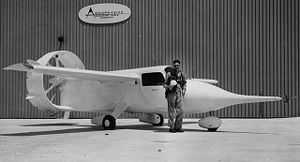 |
16 November 1962 |
Flying Platform, 1955–1956
- HO-1 Pawnee – Hiller (redesignated as VZ-1 in 1956)
- HO-2 – de Lackner Helicopters (redesignated as HZ-1 in 1956)
Helicopter, Cargo, 1956–1962
- HC-1A Sea Knight (redesignated as CH-46C in 1962)
- HC-1B Chinook (redesignated as CH-47A in 1962)
Helicopter, Observation, 1956–1962
- HO-1 – Sud-Ouest
- HO-2 – Hughes
- HO-3 – Brantly
- HO-4 – Bell (redesignated as OH-4A in 1962)
- HO-5 – Fairchild Hiller (redesignated as OH-5A in 1962)
- HO-6 – Hughes (redesignated as OH-6A in 1962)
Helicopter, Utility, 1956–1962
- HU-1 Iroquois – Bell (redesignated as UH-1 in 1962)
Helicopter, Experimental, 1956–1962
- HZ-1 Aerocycle – de Lackner Helicopters
Vertical Takeoff and Landing Research, 1956–1962

- VZ-1 Pawnee – Hiller
- VZ-2 – Vertol
- VZ-3 Vertiplane – Ryan
- VZ-4 Convertiplane – Doak
- VZ-5 Fledgling – Fairchild
- VZ-6 – Chrysler
- VZ-7-Curtiss-Wright
- VZ-8 Airgeep – Piasecki
- VZ-9 Avrocar – Avro Canada
- VZ-10 Hummingbird – Lockheed (redesignated as XV-4 in 1962)
- VZ-11 Vertifan – Ryan (redesignated as XV-5 in 1962)
- VZ-12 Kestrel – Hawker Siddeley (redesignated as XV-6 in 1962)
Unified System, 1962–present
Airborne Laser
| Sequence | Name | Manufacturer | Image | Notes/Notable Variants |
|---|---|---|---|---|
| AL-1 | Boeing | |
[9] Airborne Laser Testbed |
Airship
| Sequence | Name | Manufacturer | Image | Notes/Notable Variants |
|---|---|---|---|---|
| Z-1 | Goodyear | [9] | ||
| Z-2 | Sentinel | Westinghouse Airships | ||
| Z-3 | American Blimp | [3] |
Anti-Submarine Warfare
| Sequence | Name | Manufacturer | Image | Notes/Notable Variants | |||
|---|---|---|---|---|---|---|---|
| S-1 | Skipped | ||||||
| S-2 | Tracker | Grumman Aircraft |  |
Formerly S2F | |||
| S-3 | Viking Shadow |
Lockheed Corporation |  |
||||
Attack
| Sequence | Name | Manufacturer | Image | Notes/notable variants |
|---|---|---|---|---|
| A-1 | Skyraider | Douglas |  |
(formerly designated AD) |
| A-2 | Savage | North American |  |
(formerly designated AJ) |
| A-3 | Skywarrior | Douglas | (formerly designated A3D) | |
| A-4 | Skyhawk | Douglas |  |
(formerly designated A4D) |
| A-5 | Vigilante | North American |  |
(formerly designated A3J) |
| A-6 | Intruder | Grumman |  |
(formerly designated A2F) |
| A-7 | Corsair II | Ling-Temco-Vought |  |
|
| A-9 | Northrop | Losing contender for the AX competition | ||
| A-10 | Thunderbolt II | Fairchild Republic |  |
Winning contender for the AX competition |
| A-12 | Avenger II | McDonnell Douglas / General Dynamics |  |
cancelled |
| F/A-18C/D | Hornet | McDonnell Douglas | 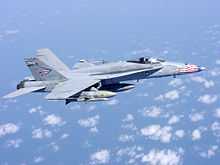 |
[10] |
| F/A-18E/F | Super Hornet | Boeing | 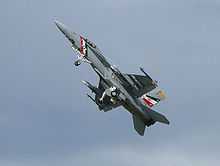 |
[10] |
| A-26 | Invader | Douglas |  |
(redesignated from B-26 in 1966) |
| A-29 | Super Tucano | Embraer | ||
| A-37 | Dragonfly | Cessna |  |
(originally designated AT-37) |
Bomber
| Sequence | Name | Manufacturer | Image | Notes/Notable Variants |
|---|---|---|---|---|
| B-1 | Lancer | Rockwell International |  |
|
| B-2 | Spirit "Stealth Bomber" |
Northrop Grumman | |
Cargo
| Sequence | Name | Manufacturer | Image | Notes/Notable Variants |
|---|---|---|---|---|
| C-1 | Trader | Grumman |  |
(formerly designated TF) |
| C-2 | Greyhound | Grumman | _2010.jpg) |
|
| C-3 | Martin 4-0-4 | Martin |  |
(formerly designated RM-1Z) Martin 4-0-4 airliners for use by the US Marine Corps and US Coast Guard |
| C-4 | Academe | Gulfstream | Used for training A-6 Intruder Naval Flight Officers. | |
| C-5 | Galaxy | Lockheed |  |
|
| C-6 | Ute | Beechcraft |  |
Beechcraft 90 King Air, re-designated U-21 Ute |
| C-7 | Caribou | de Havilland Canada |  |
|
| C-8 | Buffalo | de Havilland Canada |  |
|
| C-9 | Nightingale | McDonnell-Douglas | 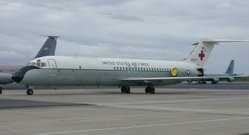 |
|
| C-10 | Jetstream | Handley Page | USAF 68-10378/10388 (were to be offset purchase for RAF F-111K – both cancelled) | |
| C-10 | McDonnell-Douglas | .jpg) |
Winner of the KC-X competition (after cancellation of C-10 Jetstream, C-10 designation re-used) | |
| C-11 | Gulfstream II | Gulfstream |  |
|
| C-12 | Beechcraft |  |
||
| C-14 | Boeing |  |
AMST contender | |
| C-15 | McDonnell-Douglas |  |
AMST contender | |
| C-17 | Globemaster III | Boeing |  |
|
| C-18 | Boeing 707–320 | Boeing |  |
|
| C-19 | Boeing 747–100 | Boeing | 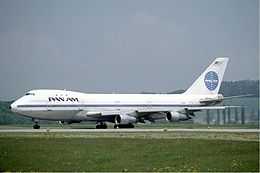 |
|
| C-20 | Gulfstream III | Gulfstream | C-20A / B / C / D / E | |
| C-20 | Gulfstream IV | Gulfstream | C-20F / G / H / J | |
| C-21 | Learjet 35 | Learjet |  |
|
| C-22 | Boeing 727 | Boeing | .jpg) |
Air National Guard and National Guard Bureau personnel transports |
| C-23 | Sherpa | Shorts |  |
Military logistics transports for use in Europe and the US by the US Air Force and US Army |
| C-24 | DC-8F-54 | Douglas | A single DC-8-54F used for avionic trials as the EC-24A | |
| C-25 | Boeing | .jpg) |
Presidential VVIP transport | |
| C-26 | Fairchild |  |
||
| C-27 | Spartan | Alenia |  |
|
| C-28 | Titan | Cessna | ||
| C-29 | B Ae 125-800 | British Aerospace | Airways and navaid checker | |
| C-32 | Boeing | 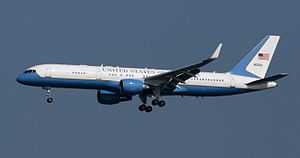 |
VIP transport | |
| C-35 | Cessna | |||
| C-37 | Gulfstream V | Gulfstream |  |
|
| C-38 | Gulfstream G100 | Gulfstream | (formerly IAI Astra SPX) | |
| C-40 | Boeing 737-700c | Boeing |  |
(replacement for the C-9A Nightingale in USAF and C-9B Skytrain II in USN) |
| C-41 | C-212 series 200 Aviocar | Construcciones Aeronáuticas SA | [3] | |
| C-45 | EADS | Losing K-X contender[3] | ||
| C-46 | Boeing | Winner of the K-X competition over the EADS KC-45 | ||
| KC-767 | Boeing | 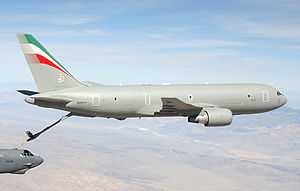 |
Out of sequence designation used for foreign military sales and trials aircraft:- Multi-Role Tanker Transports exported to Japan and Italy[3] | |
| UC-880 | Convair |  |
Out of sequence designation used for foreign military sales and trials aircraft:- A single Convair 880 converted to tanker to support trials from the NATC at Patuxent River[11] |
Drone
| Sequence | Name | Manufacturer | Image | Notes/Notable Variants | |||
|---|---|---|---|---|---|---|---|
| Q-1 | Predator Warrior |
General Atomics | 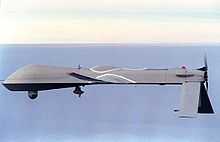 |
[3] MQ-1C Warrior | |||
| Q-2 | Pioneer | AAI Corporation Israel Aircraft Industries |
|
||||
| Q-3 | Dark Star | Lockheed Martin Boeing |
 |
||||
| Q-4 | Global Hawk | Northrop Grumman |  |
||||
| Q-5 | Hunter | Israel Aircraft Industries |  |
||||
| Q-6 | Outrider | Alliant Techsystems | |||||
| Q-7 | Shadow | AAI Corporation |  |
||||
| Q-8 | Fire Scout | Northrop Grumman |  |
||||
| Q-9 | Reaper Altair |
General Atomics |  |
Originally "Predator B" | |||
| Q-10 | SnowGoose | MMIST | |||||
| Q-11 | Raven | AeroVironment |  |
||||
| Q-12 | Requested for Q-1C – Skipped | ||||||
| Q-13 | Skipped | ||||||
| Q-14 | Dragon Eye | AeroVironment | _on_display_at_the_2005_Naval_UAV_Air_Demo_held_at_the_Webster_Field_Annex_of_Naval_Air_Station_Patuxent_River.jpg) |
||||
| Q-15 | Neptune | DRS Technologies |  |
||||
| Q-16 | T-Hawk | Honeywell |  |
||||
| Q-17 | SpyHawk | MTC Technologies | |||||
| Q-18 | Hummingbird | Boeing | |||||
| Q-19 | Aerosonde | AAI Corporation | [3] | ||||
| Q-20 | Puma | AeroVironment | |||||
| Q-21 | Integrator | Boeing Insitu | |||||
| Non-sequential designations | |||||||
| Q-170 | Sentinel | Lockheed Martin |  |
||||
Electronic Warfare
| Sequence | Name | Manufacturer | Image | Notes/Notable Variants |
|---|---|---|---|---|
| E-1 | Tracer | Grumman Aircraft |  |
Formerly WF |
| E-2 | Hawkeye | Grumman Aircraft | |
Formerly W2F |
| E-3 | Sentry | Boeing |  |
|
| E-4 | "Nightwatch" | Boeing |  |
|
| E-5 | Eagle | Windecker Industries | ||
| E-6 | Mercury | Boeing |  |
TACAMO |
| E-7 | Designation proposed for EC-18B | |||
| E-8 | Joint STARS | Northrop Grumman | |
|
| E-9 | Widget | de Havilland Canada |  |
|
| E-10 | MC2A | Boeing Northrop Grumman |
||
| E-11 | Bombardier Northrop Grumman |
Battlefield Airborne Communications Node platform | ||
| E-767 | Boeing |  |
Out of sequence designation used for foreign military sales and trials aircraft:- AEW&C aircraft for the Japanese Self-Defence Forces[3] |
Experimental, 1948–present
In addition to aircraft intended to support military operations, the armed forces of the United States have also supported efforts to push the boundaries of aeronautical and aerospace knowledge. Some of the best-known of these projects are the aircraft designated in the "X-series", which led them to become known as "X-planes".
| Name | Manufacturer Agency |
Image | Maiden flight | Notes/Notable Variants |
|---|---|---|---|---|
| X-1 | Bell Aircraft USAF, NACA |
 |
January 19, 1946 | High-speed and high-altitude testing. First aircraft to break the sound barrier. Proved aerodynamic viability of thin wing sections.[12] |
| X-2 "Starbuster" |
Bell Aircraft USAF |
 |
June 27, 1952 | High-speed and high-altitude testing. First aircraft to exceed Mach 3.[13] |
| X-3 Stiletto |
Douglas Aircraft USAF, NACA |
 |
October 27, 1952 | Titanium alloy construction; low aspect ratio wings. Planned to test long-duration high-speed flight. Incapable of reaching design speed, but Provided insights into inertia coupling.[14] |
| X-4 Bantam |
Northrop USAF, NACA |
 |
December 15, 1948 | Evaluated handling characteristics of tailless aircraft in the transonic speed region.[15] |
| X-5 | Bell Aircraft USAF, NACA |
 |
June 20, 1951 | First aircraft to fly with Variable-sweep wing wings.[16] (many other aircraft had previously flown with variable geometry wings, but none with variable sweep wings) |
| X-6 | Convair USAF, AEC |
 |
Not flown | Modified Convair B-36 for study of Aircraft Nuclear Propulsion; not built. NB-36H testbed tested reactor.[17] |
| X-7 "Flying Stove Pipe" |
Lockheed Tri-service |
April 1951 | High-speed testbed for ramjet engines.[18] | |
| X-8 Aerobee |
Aerojet NACA, USAF, USN |
Upper air research vehicle and sounding rocket.[19] | ||
| X-9 Shrike |
Bell Aircraft USAF |
April 1949 | Guidance and propulsion technology testbed. Assisted development of GAM-63 Rascal missile.[20] | |
| X-10 | North American Aviation USAF |
 |
October 13, 1953 | Testbed for SM-64 Navajo missile.[21] |
| X-11 | Convair USAF |
 |
June 11, 1957 | Testbed for SM-65 Atlas missile.[22] |
| X-12 | Convair USAF |
July, 1958 | Advanced testbed for SM-65 Atlas missile.[23] | |
| X-13 Vertijet |
Ryan Aeronautical USAF, USN |
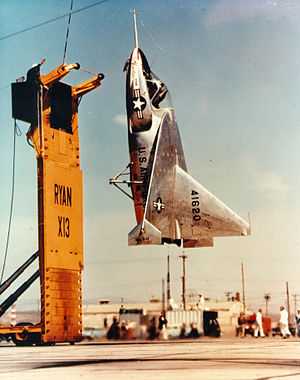 |
December 10, 1955 | Vertical takeoff and landing (VTOL) testbed. Evaluated tailsitting configuration for VTOL flight.[24] |
| X-14 | Bell Aircraft USAF, NASA |
 |
February 19, 1957 | VTOL testbed. Examined the vectored thrust configuration for VTOL flight.[25] |
| X-15 | North American Aviation USAF, NASA |
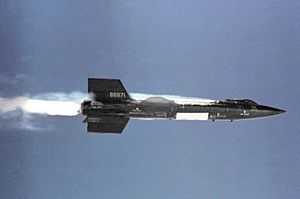 |
June 8, 1959 | Hypersonic (Mach 6), high-altitude (350,000 feet (110,000 m)) testing. First manned hypersonic aircraft; capable of suborbital spaceflight.[26] |
| X-16 | Bell Aircraft USAF |
Never flew | High-altitude reconnaissance aircraft project.[27] "X-16" designation used as cover story.[28] | |
| X-17 | Lockheed USAF, USN |
April 1956 | Tested the effects of high Mach number reentry.[29] | |
| X-18 | Hiller Aircraft USAF, USN |
 |
November 24, 1959 | VTOL/Short take-off and vertical landing (STOVL) testbed. Evaluated the tiltwing concept for VTOL flight.[30] |
| X-19 | Curtiss-Wright Tri-service |
November 1963 | Tandem tiltrotor VTOL transport testbed.[31] XC-143 designation proposed.[32] | |
| X-20 Dyna-Soar |
Boeing USAF |
 |
Never built | Reusable spaceplane for military missions.[33] |
| X-21 | Northrop USAF |
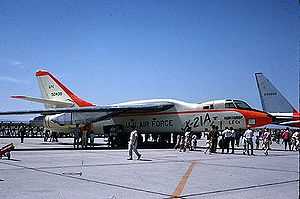 |
April 18, 1963 | Boundary layer control testbed.[34] |
| X-22 | Bell Aircraft Tri-service |
 |
March 17, 1966 | Quad ducted fan tiltrotor STOVL testbed.[35] |
| X-23 PRIME |
Martin Marietta USAF |
December 21, 1966 | Maneuvering atmospheric reentry effects testbed.[36] Note: Designation never officially assigned.[37] | |
| X-24 | Martin Marietta USAF, NASA |
  |
August 1, 1973 | Low-speed lifting body handling testbed. Lifting body aerodynamic shape trials.[38] |
| X-25 | Bensen USAF |
 |
December 6, 1955 | Light autogyro for emergency use by downed pilots.[39] |
| X-26 Frigate |
Schweizer DARPA, US Army, USN |
 |
1967 | Training glider for yaw-roll coupling Quiet observation aircraft testbed.[40] |
| X-27 | Lockheed |  |
Never flew | High performance fighter prototype.[41] |
| X-28 Sea Skimmer |
Osprey Aircraft USN |
 |
August 12, 1970 | Inexpensive aerial policing seaplane testbed.[42] |
| X-29 | Grumman DARPA, USAF, NASA |
1984 | Forward-swept wing testbed.[43] | |
| X-30 NASP |
Rockwell NASA, DARPA, USAF |
 |
Never built | Single stage to orbit spaceplane prototype.[44] |
| X-31 | Rockwell DARPA, USAF, BdV |
1990 | Thrust vectoring supermaneuverability testbed. ESTOL testbed.[45] | |
| X-32 | Boeing USAF, USN, RAF |
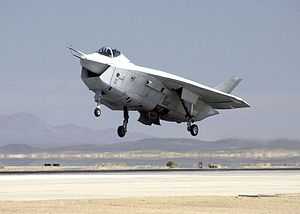 |
September 2000 | Joint Strike Fighter prototype.[46] |
| X-33 Venture Star |
Lockheed Martin NASA |
 |
Prototype never completed | Half-scale reusable launch vehicle prototype.[47] |
| X-34 | Orbital Sciences NASA |
 |
Never flew | Reusable unmanned spaceplane testbed.[48] |
| X-35 | Lockheed Martin USAF, USN, RAF |
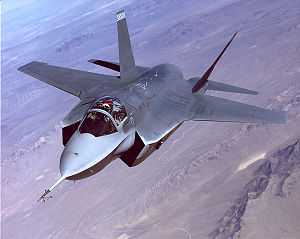 |
2000 | Joint Strike Fighter prototype.[49] |
| X-36 | McDonnell Douglas/Boeing NASA |
 |
May 17, 1997 | 28% scale tailless fighter testbed.[50] |
| X-37 | Boeing USAF, NASA |
 |
April 7, 2006 (drop test) April 22, 2010 (orbital flight) |
Reusable orbital spaceplane.[51] |
| X-38 | Scaled Composites NASA |
 |
1999 | Lifting body Crew Return Vehicle demonstrator.[52] |
| X-39 | Unknown USAF |
Unknown | Future Aircraft Technology Enhancements (FATE) program.[53] Note: Designation never officially assigned.[37] | |
| X-40 | Boeing USAF, NASA |
August 11, 1998 | 80% scale Space Maneuver Vehicle testbed. X-37 prototype.[54] | |
| X-41 | Unknown USAF |
Unknown | Maneuvering re-entry vehicle.[55] | |
| X-42 | Unknown USAF |
Unknown | Expendable liquid propellant upper-stage rocket.[56] | |
| X-43 Hyper-X |
Microcraft NASA |
 |
June 2, 2001 | Scramjet hypersonic testbed.[57] |
| X-44 MANTA |
Lockheed Martin USAF, NASA |
Cancelled | F-22-based Multi-Axis No-Tail Aircraft thrust vectoring testbed.[58] | |
| X-45 | Boeing DARPA, USAF |
 |
May 22, 2002 | Unmanned combat air vehicle (UCAV) demonstrator.[59] |
| X-46 | Boeing DARPA, USN |
 |
Cancelled | Naval UCAV demonstrator.[60] |
| X-47A Pegasus X-47B |
Northrop Grumman DARPA, USN |
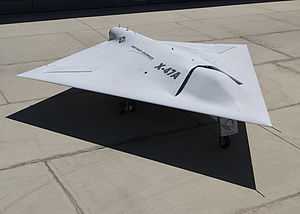 |
February 23, 2003 | Naval UCAV demonstrator.[61] |
| X-48 | Boeing NASA |
 |
July 20, 2007 | Blended Wing Body (BWB) testbed.[62] |
| X-49 Speedhawk |
Piasecki Aircraft US Army |
 |
July 29, 2007 | Compound helicopter Vectored Thrust Ducted Propeller (VTDP) testbed.[3] |
| X-50 Dragonfly |
Boeing DARPA |
24 November 2003 | Canard Rotor/Wing testbed.[63] | |
| X-51 Waverider |
Boeing USAF |
 |
26 May 2010[64] | Hypersonic scramjet demonstrator.[65] |
| X-52 | Number skipped to avoid confusion with B-52.[37] | |||
| X-53 | Boeing Phantom Works NASA, USAF |
 |
November 2002 | Active Aeroelastic Wing testbed.[66] |
| X-54 | Gulfstream Aerospace NASA |
Future | Supersonic transport testbed.[3] | |
| X-55 | Lockheed Martin Skunk Works USAF |
June 2, 2009 | Advanced Composite Cargo Aircraft (ACCA). Molded composite fuselage and empennage testbed.[67] | |
Fighter
| Sequence | Name | Manufacturer | Image | Notes/Notable Variants |
|---|---|---|---|---|
| F-1 | Fury | North American |  |
(previously designated FJ-2, FJ-3 & FJ-4) |
| F-2 | Banshee | McDonnell | 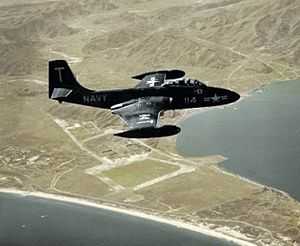 |
(previously designated F2H) |
| F-3 | Demon | McDonnell |  |
(previously designated F3H) |
| F-4 | Phantom II | McDonnell Douglas |  |
(previously designated F4H and F-110) |
| F-5 | Freedom Fighter | Northrop |  |
|
| F-6 | Skyray | Douglas | 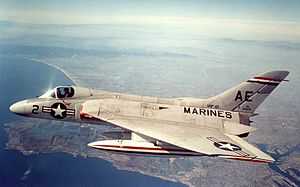 |
(previously designated F4D) |
| F-7 | Sea Dart | Convair |  |
(previously designated F2Y) |
| F-8 | Crusader | Vought | (previously designated F8U) | |
| F-9 | Cougar | Grumman |  |
(previously designated F9F-6) |
| F-10 | Skyknight | Douglas | 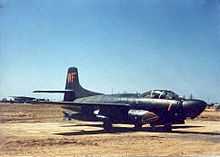 |
(previously designated F3D) |
| F-11 | Tiger | Grumman |  |
(previously designated F11F) |
| F-12 | Lockheed |  |
Two-seat Fighter version of the A-12 reconnaissance aircraft | |
| F-14 | Tomcat | Grumman |  |
|
| F-15 | Eagle | McDonnell Douglas | ||
| F-16 | Fighting Falcon | General Dynamics / Lockheed Martin | Winning contender in the LWF contest | |
| F-17 | Cobra | Northrop | 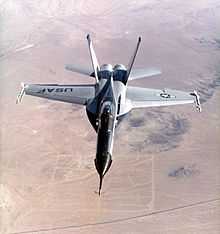 |
Losing contender in the LWF contest, developed into the F/A-18 Hornet |
| F-18A/B/C/D | Hornet | McDonnell Douglas |  |
Developed from the YF-17 as a shipboard fighter Attack aircraft |
| F/A-18E/F | Super Hornet | Boeing | .jpg) |
Enlarged F/A-18 with bigger everything[3] |
| F-20 | Tigershark | Northrop |  |
The ultimate Tiger development powered by a single F404 afterburning turbofan, but no production |
| F-21 | Kfir C-2 | Israel Aircraft Industries |  |
Kfir C2 aircraft for US Navy dissimilar combat training and aggressor training |
| F-22 | Raptor | Lockheed Martin | 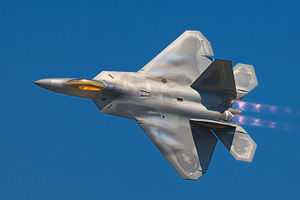 |
[3] |
| F-23 | Black Widow II | Northrop / McDonnell Douglas |  |
Lost out to the F-22 in competition |
| F-35 | Lightning II | Lockheed Martin | 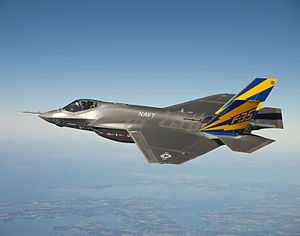 |
Production version of the X-35, winner of the JSF competition[3] |
| YF-110 | MiG-21s | Mikoyan-Gurevich |  |
Note: Captured foreign aircraft used for evaluation and aggressor were given designations in sequence—based on chronology—with "black" project aircraft, continuing the pre-1962 F series.[68] Designation used for captured MiG-21s and new-build J-7s[69] |
| YF-112 | Su-22 | Sukhoi | Note: Captured foreign aircraft used for evaluation and aggressor were given designations in sequence—based on chronology—with "black" project aircraft, continuing the pre-1962 F series.[68] – obtained from Egypt or Allegedly used for captured MiGs[69] | |
| YF-113 | MiG-23s | Mikoyan-Gurevich | Note: Captured foreign aircraft used for evaluation and aggressor were given designations in sequence—based on chronology—with "black" project aircraft, continuing the pre-1962 F series.[68] – Designation used for captured MiG-17s and[68][69] | |
| YF-114 | MiG-17 | Mikoyan-Gurevich | Note: Captured foreign aircraft used for evaluation and aggressor were given designations in sequence—based on chronology—with "black" project aircraft, continuing the pre-1962 F series.[68] – Designation used for captured MiG-17s[69] | |
| F-117 | Nighthawk | Lockheed | 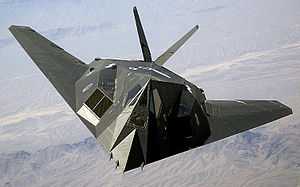 |
Production version of the HAVE BLUE experimental stealth aircraft |
| F-117D Tacit Blue | TACIT BLUE | 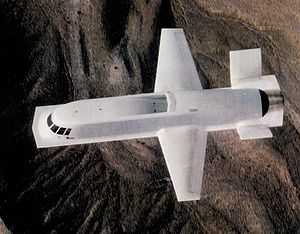 |
A stealth experimental aircraft[69] | |
Note: Captured foreign aircraft used for evaluation and aggressor were given designations in sequence—based on chronology—with "black" project aircraft, continuing the pre-1962 F series.[68]
Glider
| Sequence | Name | Manufacturer | Image | Notes/Notable Variants |
|---|---|---|---|---|
| TG-1 | Schweizer | |||
| TG-2 | Schweizer | |||
| TG-3 | Schweizer[71] | |||
| TG-4 | Schweizer[71] | |||
| TG-5 | Schweizer | |||
| TG-6 | Schweizer | |||
| TG-7 | Schweizer[71] | |||
| TG-8 | Schweizer | |||
| TG-9 | Schleicher[71] | |||
| TG-10 | Let[3][71] | |||
| TG-11 | Stemme[71] | |||
| TG-12 | Caproni Vizzola[3] | |||
| TG-13 | Skipped | |||
| TG-15 | Aeromot[3] | |||
| TG-15 | Schempp-Hirth[3] | |||
| TG-16 | DG Flugzeugbau |
Helicopter
Unlike most other categories of aircraft, the introduction of the tri-service designation system in 1962 did not result in a wholesale redesignation of helicopters. While six types received new designations in the unified, "re-started" sequence, the original "H-" series of designations that started in 1948 was also continued, and no further types of rotorcraft have been designated in the "post-1962" system.
| Sequence | Name | Manufacturer | Image | First flight | Notes/Notable Variants |
|---|---|---|---|---|---|
| H-1 Iroquois | Iroquois Huey |
Bell Helicopter |  |
22 October 1956 | Formerly H-40 Formerly HU-1 UH-1N Twin Huey UH-1Y Venom |
| H-1 Cobra | Cobra SeaCobra SuperCobra Viper |
Bell Helicopter |  |
Formerly AH-1 Cobra AH-1 SuperCobra AH-1Z Viper | |
| H-2 Seasprite | Seasprite | Kaman Aircraft |  |
2 July 1959 | Formerly HU2K SH-2G Super Seasprite |
| H-3 Sea King | Sea King "Jolly Green Giant" |
Sikorsky Aircraft |  |
11 March 1959 | Formerly HSS-2 CH-/HH-3 Sea King |
| H-4 | Bell Helicopter | 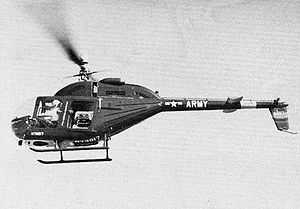 |
8 December 1962 | Formerly HO-4 | |
| H-5 | Fairchild Hiller |  |
21 January 1963 | Formerly HO-5 | |
| H-6 Cayuse | Cayuse Little Bird |
Hughes Helicopters McDonnell Douglas Boeing Helicopters |
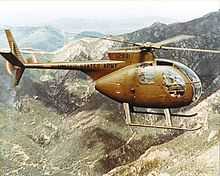 |
27 February 1963 | Formerly HO-6 MH-6 Little Bird AH-6 |
Observation
| Sequence | Name | Manufacturer | Image | First flight | Notes/Notable Variants |
|---|---|---|---|---|---|
| O-1 | Bird Dog | Cessna Aircraft |  |
14 December 1949 | Formerly L-19 |
| O-2 | Skymaster | Cessna Aircraft |  |
January 1967 | |
| O-3 | "Quiet Star" | Lockheed Missiles & Space |  |
1969 | |
| O-4 | Wren Aircraft | 1963 (Wren 460) |
Not proceeded with. | ||
| O-5 | ARL | de Havilland Canada |  |
27 March 1975 (DHC-7) |
Formerly RC-7 |
Patrol
| Sequence | Name | Manufacturer | Image | First flight | Notes/Notable Variants |
|---|---|---|---|---|---|
| P-1 | Skipped | ||||
| P-2 | Neptune | Lockheed Corporation |  |
17 May 1945 | Formerly P2V |
| P-3 | Orion ARIES |
Lockheed Corporation | 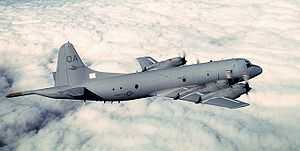 |
25 November 1959 | Formerly P3V WP-3D Orion EP-3 Aries |
| P-4 | Privateer | Consolidated Aircraft |  |
1943 | Formerly PB4Y-2K / P4Y-2K) |
| P-5 | Marlin | Glenn L. Martin Company |  |
30 May 1948 | Formerly P5M |
| P-6 | Skipped – presumably because of Martin P6M which was canceled a few years previously | ||||
| P-7 | Lockheed Corporation | – | Long-Range Air ASW-Capable Aircraft Not built | ||
| P-8 | Poseidon | Boeing | 25 April 2009 | [3] | |
Reconnaissance
| Sequence | Name | Manufacturer | Image | First flight | Notes/Notable Variants |
|---|---|---|---|---|---|
| R-1 | Dragon Lady | Lockheed Corporation | 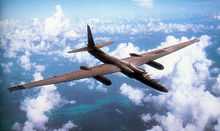 |
August 1981 | |
| R-2 | Skipped | ||||
| R-3 | Possibly assigned to a Black Project Speculated: TR-3 Black Manta Speculated: SR-3 Blackstar | ||||
Spaceplane
The only designation in the "Spaceplane" series, the MS-1A shares a designation letter with the anti-submarine warfare category, and is perhaps unique among MDS identifiers as being assigned to a future, and currently not wholly defined, concept, as opposed to a specific project.[3][72]
Tanker
No specialised types have been acquired to receive a stand-alone 'K for Tanker' designation; for aircraft modified for use as tankers, see the parent aircraft in the proper sequence.
Trainer, 1962, 1990–present
Despite the adoption of the unified Mission Designation System in 1962, only two aircraft were designated in the new series, both former Navy types. The old series continued in use until 1990, at which point a new series was started over at T-1, with the previous T-2 still being in use. However, the old series has still seen new designations being assigned. The next designation available in the 'T' series is T-52 or T-7, depending on which series is continued.
| Sequence | Name | Manufacturer | Image | First flight | Notes/Notable Variants |
|---|---|---|---|---|---|
| 1962 Sequence | |||||
| T-1 | SeaStar | Lockheed Corporation |  |
15 December 1953 | Formerly T2V. |
| T-2 | Buckeye | North American Aviation | |
31 January 1958 | Formerly T2J. |
| 1990 Sequence | |||||
| T-1 | Jayhawk | Raytheon Hawker Beechcraft |
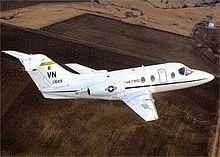 |
||
| T-2 | Skipped | T-2 Buckeye was still in service. | |||
| T-3 | Firefly | Slingsby Aviation |  |
1991 | |
| T-4 | Skipped | ||||
| T-5 | Skipped | ||||
| T-6 | Texan II | Hawker Beechcraft | 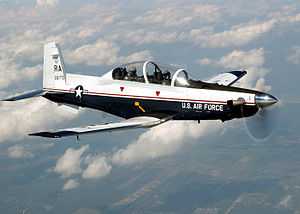 |
July 1998 | Named in honor of AT-6 Texan |
Utility, 1955–present
| Sequence | Name | Manufacturer | Image | Notes/Notable Variants |
|---|---|---|---|---|
| U-1 | Otter | de Havilland Canada | ||
| U-2 | Dragon Lady | Lockheed Corporation | ||
| U-3 | Blue Canoe | Cessna | ||
| U-4 | Aero Commander | Aero Design | ||
| U-5 | Twin Courier | Helio | ||
| U-6 | Beaver | de Havilland Canada | ||
| U-7 | Super Cub | Piper | ||
| U-8 | Seminole | Beechcraft | ||
| U-9 | Aero Commander | Aero Design | ||
| U-10 | Super Courier | Helio | ||
| U-11 | Aztec | Piper | ||
| U-12 | Skipped | |||
| U-13 | Skipped | |||
| U-14 | Skipped | |||
| U-15 | Skipped | |||
| U-16 | Albatross | Grumman | ||
| U-17 | Skywagon | Cessna | ||
| U-18 | Navion | North American/Ryan | ||
| U-19 | Sentinel | Stinson | ||
| U-20 | Cessna | |||
| U-21 | Ute | Beechcraft | ||
| U-22 | Beechcraft | |||
| U-23 | Peacemaker | Fairchild Hiller/Pilatus | ||
| U-24 | Courier | Helio | ||
| U-25 | Guardian | Dassault-Breguet | ||
| U-26 | Super Skywagon | Cessna | ||
| U-27 | Caravan | Cessna | ||
| U-28 | Pilatus[3] | |||
| U-38 | Twin Condor | Schweizer |
Vertical and Short Take-off and Landing Aircraft
| Sequence | Name | Manufacturer | Image | First flight | Notes/Notable Variants |
|---|---|---|---|---|---|
| V-1 | Mohawk | Grumman Aircraft | 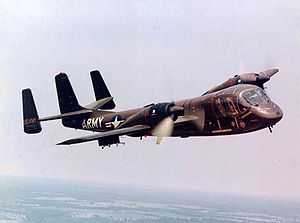 |
14 April 1959 | Formerly AO-1 |
| V-2 | Caribou | de Havilland Canada | |
30 July 1958 | Formerly AC-1 Redesignated as C-7 |
| V-3 | Bell Helicopter |  |
11 August 1955 | Formerly H-33 Formerly V-3 in Convertiplane series | |
| V-4 | Hummingbird | Lockheed Corporation |  |
7 July 1962 | Formerly VZ-10 |
| V-5 | Vertifan | Ryan Aeronautical | 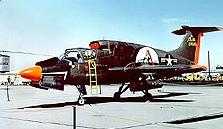 |
25 May 1964 | Formerly VZ-11 |
| V-6 | Kestrel | Hawker Siddeley | 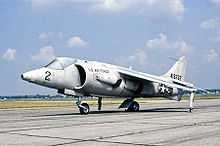 |
7 March 1964 | VZ-12 was used for the P.1127 development model, but these were never delivered. XV-6A used for the six evaluation aircraft supplied by the UK. |
| V-7 | Buffalo | de Havilland Canada |  |
22 September 1961 | Formerly AC-2 Redesignated as C-8 |
| V-8 | "Fleep" | Ryan Aeronautical |  |
1961 | Designation later reused. |
| V-8 | Harrier | Hawker Siddeley |  |
28 December 1967 | AV-8B Harrier II McDonnell Douglas/British Aerospace |
| V-9 | Hughes Helicopters |  |
5 November 1964 | ||
| V-10 | Bronco | Rockwell International Boeing |
|
16 July 1965 | |
| V-11 | Marvel | Parsons Corporation |  |
1 December 1965 | |
| V-12 | Parsons Corporation | |
1961 (Turbo-Porter) |
Cancelled, designation reused. | |
| V-12 | Rockwell International |  |
1978 (tethered hover) |
||
| V-13 | not used | ||||
| V-14 | not used | Skipped to avoid confusion with X-14.[73] | |||
| V-15 | Bell Helicopter |  |
3 May 1977 | ||
| V-16 | Advanced Harrier | McDonnell Douglas British Aerospace |
– | Not built; developed into AV-8B | |
| V-17 | not used | Assigned to a U.S. Army project but not used.[73] | |||
| V-18 | Twin Otter | de Havilland Canada |  |
20 May 1965 (DHC-6) |
|
| V-19 | not used | Assigned to a U.S. Navy project but cancelled.[73] | |||
| V-20 | Chiricahua | de Havilland Canada |  |
1979 | |
| V-21 | PACES | Airship Industries | 1983 | Unconfirmed designation.[73] | |
| V-22 | Osprey | Bell Helicopter Boeing Helicopters |
.jpg) |
19 March 1989 | |
| V-23 | Scout | Dominion Aircraft |  |
21 April 1975 (Skytrader) |
|
Un-designated foreign aircraft operated by the United States
- Airspeed Horsa – Airspeed Ltd
- Airspeed Oxford – Airspeed[74]
- Bristol Beaufighter – Bristol Aeroplane Company
- Boulton Paul Defiant – Boulton Paul Aircraft
- CAC Wirraway – Commonwealth Aircraft Corporation
- de Havilland Dominie – de Havilland[74]
- de Havilland Moth Minor – de Havilland.
- de Havilland Tiger Moth – de Havilland[74]
- Diamond DA20 – Diamond Aircraft
- Hawker Hurricane – Hawker Aircraft[74]
- Heinkel HD 22 – Heinkel Flugzeugwerke
- M28 Skytruck – PZL
- Mil Mi-17 – Mil
- Miles Master – Miles Aircraft Ltd[74]
- Morane-Saulnier MS-234[75]
- Percival Proctor[74]
- Supermarine Spitfire[74]
- Westland Lysander
See also
- "SR-91 Aurora"
- F/A-XX
- List of active United States military aircraft
- List of military aircraft of the United States (1909-1919)
- List of military aircraft of the United States (naval) (Pre-1962 designation aircraft only)
- United States unified missile designation sequence
- U.S. DoD aircraft designations table
- United States military aero engine designations
- United States military aircraft serials
References
- Notes
- ↑ AFR 66-11, AR 700-26, BUWEPSINST 13100.7, "Designating, Redesignating, and Naming of Military Aircraft", 18 September 1962
- ↑ "Lockheed B-71 (SR-71)". National Museum of the United States Air Force. October 29, 2009. Retrieved 2013-10-02.
- ↑ 3.0 3.1 3.2 3.3 3.4 3.5 3.6 3.7 3.8 3.9 3.10 3.11 3.12 3.13 3.14 3.15 3.16 3.17 3.18 3.19 3.20 3.21 3.22 3.23 3.24 3.25 3.26 3.27 3.28 3.29 Parsch 2009, "DOD 4120.15-L"
- ↑ Andrade 1979, page 60
- ↑ "HazeGray.org". rec.aviation.military FAQ, Part 4. Retrieved 2007-01-13.
- ↑ Andrade 1979, p. 162
- ↑ "Photo essay: Flight of a T-52A" U.S. Air Force.
- ↑ Chorney, Andrew. Systems of Designation, U.S. Army Aircraft, 1956–1962 System. U.S. Military Aircraft Designations 1911–2004
- ↑ 9.0 9.1 DOD 4120.15-L: Model Designation of Military Aerospace Vehicles, Department of Defense, Office of the Undersecretary of Defense (AT&L) (Defense Systems), May 12, 2004. Retrieved April 7, 2010.
- ↑ 10.0 10.1 Officially, the F/A-18 is designated in both the A-for-attack and F-for-fighter series.
- ↑ U.S. Military Aircraft Designations 1911–2004
- ↑ Jenkins, Landis and Miller 2003, pp. 5–7.
- ↑ Jenkins, Landis and Miller 2003, p. 8.
- ↑ Jenkins, Landis and Miller 2003, p. 9.
- ↑ Jenkins, Landis and Miller 2003, p. 10.
- ↑ Jenkins, Landis and Miller 2003, p. 11.
- ↑ Jenkins, Landis and Miller 2003, p. 12.
- ↑ Jenkins, Landis and Miller 2003, p. 13.
- ↑ Jenkins, Landis and Miller 2003, p. 14.
- ↑ Jenkins, Landis and Miller 2003, p. 15.
- ↑ Jenkins, Landis and Miller 2003, p. 16.
- ↑ Jenkins, Landis and Miller 2003, p. 17.
- ↑ Jenkins, Landis and Miller 2003, p. 18.
- ↑ Jenkins, Landis and Miller 2003, p. 19.
- ↑ Jenkins, Landis and Miller 2003, p. 20.
- ↑ Jenkins, Landis and Miller 2003, pp. 21–22.
- ↑ Jenkins, Landis and Miller 2003, p. 23.
- ↑ "X-16". globalsecurity.org, accessed 11 May 2010.
- ↑ Jenkins, Landis and Miller 2003, p. 24.
- ↑ Jenkins, Landis and Miller 2003, p. 25.
- ↑ Jenkins, Landis and Miller 2003, p. 26.
- ↑ Baugher 2007
- ↑ Jenkins, Landis and Miller 2003, p. 27.
- ↑ Jenkins, Landis and Miller 2003, p. 28.
- ↑ Jenkins, Landis and Miller 2003, p. 29.
- ↑ Jenkins, Landis and Miller 2003, p. 30.
- ↑ 37.0 37.1 37.2 Parsch 2009, "Missing Designations"
- ↑ Jenkins, Landis and Miller 2003, pp. 31–32.
- ↑ Jenkins, Landis and Miller 2003, p. 33.
- ↑ Jenkins, Landis and Miller 2003, p. 34.
- ↑ Jenkins, Landis and Miller 2003, p. 35.
- ↑ Jenkins, Landis and Miller 2003, p. 36.
- ↑ Jenkins, Landis and Miller 2003, p. 37.
- ↑ Jenkins, Landis and Miller 2003, p. 38.
- ↑ Jenkins, Landis and Miller 2003, p. 39.
- ↑ Jenkins, Landis and Miller 2003, pp. 40–41.
- ↑ Jenkins, Landis and Miller 2003, p. 42.
- ↑ Jenkins, Landis and Miller 2003, p. 43.
- ↑ Jenkins, Landis and Miller 2003, p. 44-45.
- ↑ Jenkins, Landis and Miller 2003, p. 46.
- ↑ Jenkins, Landis and Miller 2003, p. 47.
- ↑ Jenkins, Landis and Miller 2003, p. 48.
- ↑ Jenkins, Landis and Miller 2003, p. 49.
- ↑ Jenkins, Landis and Miller 2003, p. 50.
- ↑ Jenkins, Landis and Miller 2003, p. 51.
- ↑ Jenkins, Landis and Miller 2003, p. 52.
- ↑ Jenkins, Landis and Miller 2003, p. 53.
- ↑ Jenkins, Landis and Miller 2003, p. 54.
- ↑ Jenkins, Landis and Miller 2003, p. 55.
- ↑ Jenkins, Landis and Miller 2003, p. 56.
- ↑ Jenkins, Landis and Miller 2003, p. 57.
- ↑ Jenkins, Landis and Miller 2003, p. 58.
- ↑ Jenkins, Landis and Miller 2003, p. 60.
- ↑ "X-51 Waverider makes historic hypersonic flight". US AIr Force Public Affairs. 26 May 2010. Archived from the original on 17 Jul 2012. Retrieved 27 May 2010.
- ↑ "X-51 Scramjet Engine Demonstrator – WaveRider" globalsecurity.org. Retrieved 2010-05-11.
- ↑ Jordan 2006
- ↑ Kaufman 2009
- ↑ 68.0 68.1 68.2 68.3 68.4 68.5 Fulghum, David A., "MiGs in Nevada", Aviation Week & Space Technology, November 27, 2006
- ↑ 69.0 69.1 69.2 69.3 69.4 69.5 69.6 69.7 Parsch, Andreas (2006-11-27). "Cover Designations for Classified USAF Aircraft". Designation-Systems.Net. Retrieved 2006-12-29.
- ↑ "Edwards AFB website". Col. Joseph A. Lanni, USAF biography. Archived from the original on 2005-03-18. Retrieved 2007-01-07.
- ↑ 71.0 71.1 71.2 71.3 71.4 71.5 94th Flying Training Squadron aircraft
- ↑ MS-1A, GlobalSecurity.org. Retrieved 2010-04-08.
- ↑ 73.0 73.1 73.2 73.3 Parsch, Andreas. ""Missing" USAF/DOD Aircraft Designations". Designation-Systems.Net. Retrieved 2010-04-13.
- ↑ 74.0 74.1 74.2 74.3 74.4 74.5 74.6 Office of History, Headquarters Third Air Force, United States Air Forces in Europe: Installations and USAAF Combat Units in the United Kingdom 1942–1945, Revised and Expanded Edition. October 1980; reprinted February 1985
- ↑ Baugher, Joseph F. 1930–1937 USAAS Serial Numbers
- Bibliography
- Andrade, John M. (1979). U.S. Military Aircraft Designations and Serials Since 1909. Midland Counties Publications. ISBN 978-0-904597-22-6.
- Fahey, James C. (1946). U.S. Army Aircraft 1908–1946.
- Michael J.H. Taylor, ed. (1991). Jane's American Fighting Aircraft of the 20th Century. New York, NY: Mallard Press. ISBN 978-0-7924-5627-8.
External links
- OrBat United States of America – MilAvia Press.com: Military Aviation Publications
- U.S. Military Aircraft and Weapon Designations
- Designation-Systems.Net
- Joe Baugher Homepage
- Main Aircraft Page
- National Museum of the USAF – Home
- OrBat United States Air Force – MilAvia Press.com: Military Aviation Publications
- Brown-Shoe Navy: U.S. Naval Aviation
- Uncommon Aircraft
| ||||||||||||||||||||||||||||||||||||||||||||||||||||||||||||||||||||||||||||||||||||
| ||||||||||||||||||||||
